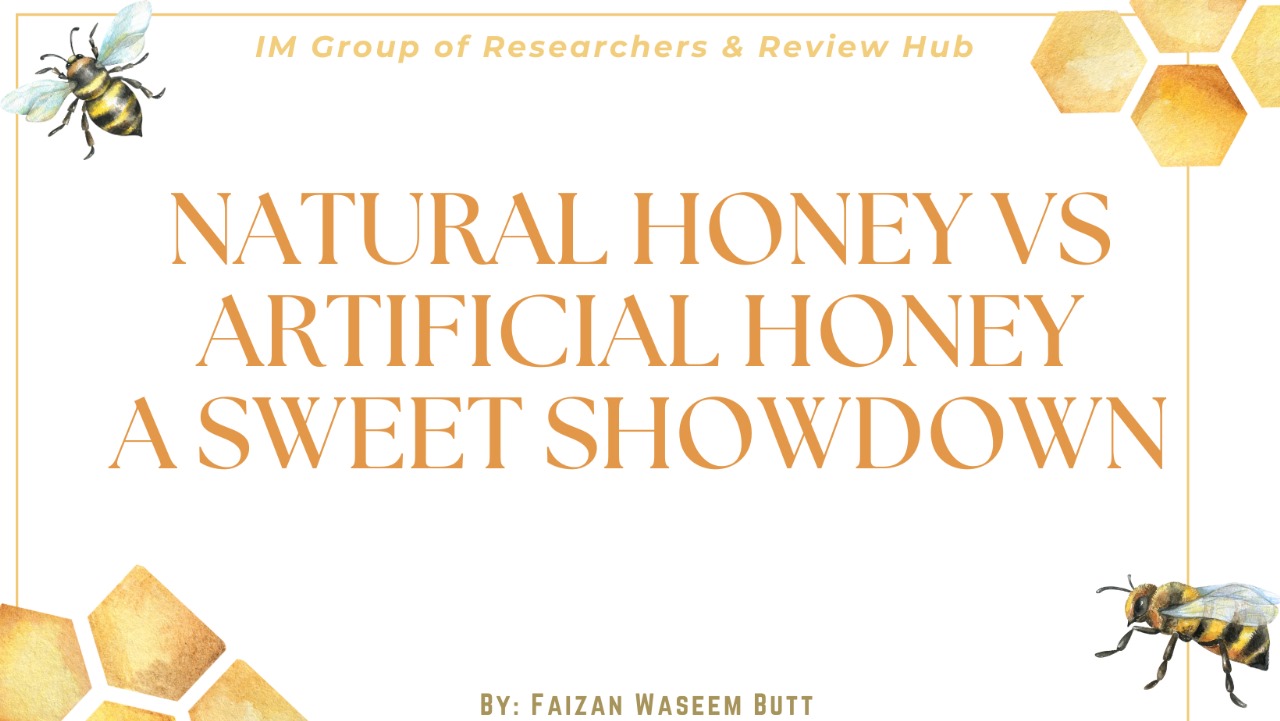Natural Honey vs. Artificial Honey: A Sweet Showdown
A short review on the science of honey – Read thoroughly, “Natural Honey vs. Artificial Honey: A Sweet Showdown”.
Author
Faizan Waseem Butt

Introduction
Honey, that golden elixir, has been celebrated for its natural sweetness and numerous health benefits for centuries. But in today’s world, where food production is often driven by profit rather than purity, it’s essential to understand the difference between natural honey and its artificial counterparts. This article delves into the distinct characteristics of natural and artificial honey, the benefits of choosing natural honey, and how to spot the real deal on your grocery store shelves.
Understanding Natural Honey
Natural honey is a true gift from nature. It is produced by honeybees from the nectar of flowers. The process starts with forager bees collecting nectar from flowers, which is then stored in their honey stomachs. This nectar undergoes enzymatic changes within the bee, turning it into honey. Back at the hive, bees regurgitate the nectar and store it in honeycombs. The water content is then reduced through a fanning process, and the bees seal the honeycomb cells with beeswax. This entire process is a testament to the wonders of nature.
Characteristics of Natural Honey
Flavour and Aroma: Natural honey has a unique flavour and aroma that varies depending on the types of flowers from which the bees collected nectar. This characteristic is known as the honey’s terroir, like how wine’s flavour varies depending on the grape variety and region.
Crystallization:
Over time, natural honey may crystallize, which is a natural process and does not affect its quality. Crystallization depends on the floral source and the honey’s composition.
Nutritional Value:
Natural honey is packed with beneficial nutrients and antioxidants, including vitamins, minerals, and enzymes. It’s a natural source of energy and is often used in traditional medicine for its healing properties.
Thixotropy:
Natural honey exhibits thixotropy, meaning it is a thick, viscous liquid at rest but becomes less viscous when agitated or stirred. This property is a clear sign of its authenticity.
Artificial Honey: The Imitation Game
Artificial honey, often referred to as “honey syrup” or “honey-flavoured syrup,” is a manufactured product that imitates the appearance and taste of natural honey. It is crucial to understand that artificial honey is not produced by bees and lacks the natural goodness of its authentic counterpart.
Characteristics of Artificial Honey
Ingredients: Artificial honey is primarily composed of sugar or high-fructose corn syrup, water, and artificial flavourings. It often contains additives and preservatives, making it far from a pure, natural product.
Uniformity:
Unlike natural honey, artificial honey is highly uniform in terms of flavor and texture. This consistency is a result of precise manufacturing processes.
Absence of Crystallization:
Artificial honey does not crystallize, as it is made to be a stable, liquid product with a long shelf life.
Lack of Nutritional Value:
Artificial honey lacks the nutritional value of natural honey. It does not contain the vitamins, minerals, and antioxidants that make natural honey a healthy choice.
Why Choose Natural Honey?
Health Benefits:
Natural honey is well-regarded for its numerous health benefits. It contains antioxidants that can help reduce oxidative stress, improve heart health, and boost the immune system. It’s also a natural cough suppressant and can aid in wound healing.
Better for Allergies:
Many people believe that consuming local, natural honey can help alleviate seasonal allergies, as it may contain small amounts of pollen from local flowers.
Pure Sweetness:
Natural honey’s distinct flavours and aromas enhance the taste of various foods and beverages. Whether you’re drizzling it over your morning oatmeal or adding it to your tea, the pure sweetness of natural honey elevates your culinary experience.
Supporting Beekeepers:
Choosing natural honey supports local beekeepers and promotes sustainable beekeeping practices, which are essential for the preservation of these vital pollinators.
How to Spot Natural Honey
Read the Label:
Check the product label for transparency. Natural honey should list a single ingredient: “honey.” Avoid products that contain added sugars, high-fructose corn syrup, or artificial flavourings.
Crystallization:
As mentioned earlier, natural honey may crystallize over time. This is a positive sign of authenticity.
Local and Raw:
Consider buying honey from local beekeepers, as it’s more likely to be pure and minimally processed. Raw honey, which is unfiltered and unheated, also retains more of its natural nutrients and flavours.
Price:
High-quality natural honey is generally more expensive than artificial honey due to the labour-intensive beekeeping process. Be prepared to invest a little more for the real deal.
Consistency:
Real honey has a thick, viscous consistency that flows slowly. If the honey appears too runny or thin, it may be artificial.
Conclusion
When it comes to honey, natural is the way to go. Natural honey not only offers superior taste and health benefits but also supports beekeepers and the vital role that bees play in pollination. In contrast, artificial honey is an imitation, laden with artificial ingredients and devoid of the goodness found in nature’s own sweet creation.
So, the next time you reach for that honey jar on the supermarket shelf, take a moment to read the label, consider its consistency, and opt for the genuine article. By choosing natural honey, you’re not only savouring the true essence of this golden elixir but also contributing to a sweeter, more sustainable world.
Also read: The Cosmic Significance of Chemistry: Exploring Its Role in Our Lives
Follow Us on

